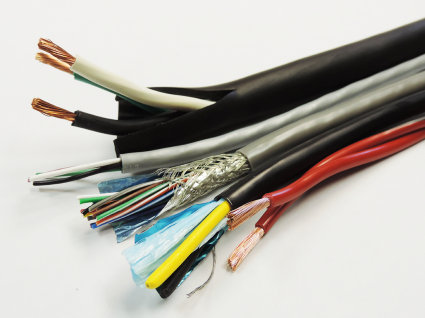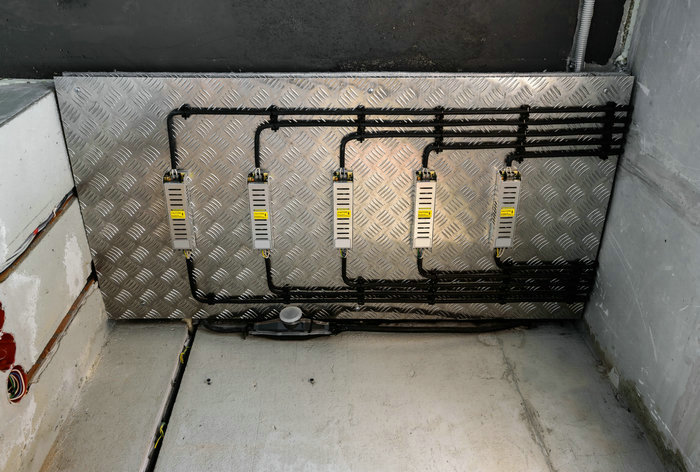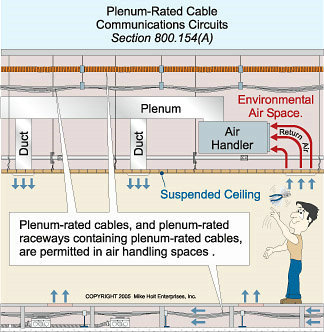Communications Multipurpose Cable (CMP) is used in structured cabling systems for data and telecommunication applications. It is typically used to connect network devices such as switches, routers, and patch panels in a data center or other professional setting.
CMP cable is required in these situations because it meets the necessary specifications for data transmission, including support for high-speed data transfer and resistance to interference.

Additionally, a plenum cable is designed to be run in plenum spaces, which are used for air circulation in a building, such as a ceiling or crawl space. This is because it’s made with special fire-resistant material that prevents flame from spreading.
You can also get a communications multipurpose cable for use in an office setting. his can be used for security cameras, door access systems, and ethernet cables.
As mentioned above, CMP cable is required in these situations because it is made with special fire-resistant materials that prevent the spread of flames and limit the release of toxic smoke. This makes it safer to use in plenum spaces than non-plenum rated cable.
Types Of Cable Ratings
The National Electrical Code (NEC) outlines various cable ratings according to their electrical and environmental specifications. The following are some of the common cable ratings according to the NEC:
- General purpose (CM) rating: The CM cable rating indicates that you can use that particular cable for a variety of applications, including commercial and residential installations.
- Riser (CRM) rating: Unlike the CM, a riser-rated cable can only be used in vertical riser applications. You can run them between floors in buildings or elevator shafts in non-plenum areas.
- Plenum (CMP) rating: CMP ratings show that you can use the cable in the plenum space of a building. A plenum space is the area above the ceiling or below the floor left during construction to allow for air circulation. Typically, cables with these ratings meet all the safety standards required to work in these spaces and are fire-resistant.
- CL2 and CL3 ratings: These are now the best cables to use in residential and commercial applications or other low-voltage areas.
- CL2R and CL3R ratings: Like the CL2 and CL3, these ratings indicates that you can use these cables in low-voltage, commercial, or residential applications. The only difference is that they’re rated for outdoor use.
The ratings ensure you know the cables that meet the safety standards and which ones are safe to use for a particular application. It is important to note that these are just a few examples of cable ratings and the NEC provides specific guidelines and requirements for various types of cables used in different applications.
Uses Of CMP Cables
CMP cables are used in different areas, such as the following:
- Data transmission at high speeds.
- Running cables in plenum spaces.

It’s essential to check the building codes and local regulations before installing any cable in order to ensure compliance and safety. Also, it’s always recommended to consult a professional electrician or network engineer before installing any cable.
Importance Of Using Plenum Cables
The main reason to use plenum rated cable is safety. This is because plenum cables are made with special fire-resistant materials that prevent the spread of flames and toxic smoke. As such, fires can be easily contained before spreading to the rest of the building.
Additionally, this makes it safer to use in plenum spaces than non-plenum rated cable. In the event of a fire, using plenum rated cable can help reduce the spread of flames and smoke, giving building occupants more time to evacuate.

Subsequently, plenum rated cable is also designed to meet the necessary data-transmission specifications, including support for high-speed data transfer and resistance to interference. This makes it suitable for data and telecommunications applications in professional settings such as data centers and offices.
You can check your ethernet cable jacket ratings to ensure that you benefit from CMP’s high data transmission speeds. Moreover, you can also install a multipurpose communications cable for all your data and telecommunication needs.
Compliance with building codes and local regulations is another important reason to use plenum rated cable. Building codes typically require the use of plenum rated cable in plenum spaces, and failure to use the correct type of cable can result in fines or other penalties.
How To Determine If A CMP Cable Is Rated
There are several ways to determine if a CMP (Communications Multi-Pair) cable is rated for plenum spaces:
- Look for the markings on the cable jacket: Plenum rated cable will have the letters “CMP” printed on the cable jacket, indicating that it meets the necessary specifications for use in plenum spaces.
- Check the product documentation: The manufacturer’s product documentation will typically indicate whether a cable is a plenum rated. This information can be found on the product packaging or the manufacturer’s website.
- Consult with a professional: A professional electrician or network engineer will be able to determine whether a cable is a plenum rated based on their knowledge and experience.
- Check the standards: Plenum rated cables must meet the standards set by organizations such as National Electric Code (NEC), Underwriters Laboratories (UL), and National Fire Protection Association (NFPA). Cables compliant with these standards will typically have a label or marking indicating compliance.
It’s important to note that even if a cable is marked as plenum rated, it’s important to check the local regulations and building codes as they may have additional requirements. It’s always recommended to consult with a professional before installing any cable.
When To Use Non-Plenum Rated Cables
Non-plenum rated cables can be used in situations where the cable will not be run through a plenum space or where the building code does not require the use of plenum rated cable. Examples of cases where non-plenum rated cables can be used include:
- In residential or commercial buildings: The cable will be run through walls, floors, or ceilings that are not part of the air circulation system.
- In industrial settings: The cable will be run in areas that are not accessible to the general public.
- In outdoor environments: The cable will run above ground or be buried underground.
It’s important to note that even if a cable is not plenum rated, it still needs to meet the necessary specifications for data transmission, including support for high-speed data transfer and resistance to interference.
It’s essential to check the building codes and local regulations before installing any cable in order to ensure compliance and safety. Also, it’s always recommended to consult a professional electrician or network engineer before installing any cable.
Using CMP Cable In Conduit
Whether or not plenum rated cable is required when it is run inside a conduit depends on the specific building code and local regulations in place. In general, a conduit is used to protect and route cables in a building and can provide an extra layer of fire protection.
However, some building codes and local regulations may still require plenum-rated cable even if it is run inside a conduit. This is because the air circulating in the plenum space can still be affected in the case of a fire.
It’s important to check the specific building codes and local regulations in place before installing any cable, as they may have specific requirements for plenum rated cable when it is run inside a conduit.
Conclusion
A CMP cable is used to provide safety and compliance in plenum spaces by preventing the spread of flames and smoke and providing high-speed data transfer and resistance to interference. It’s important to use plenum rated cable to ensure the safety of building occupants and comply with building codes and regulations.
